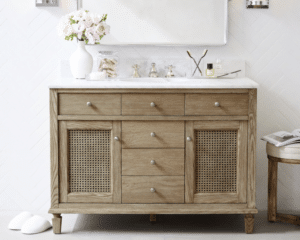
When it comes to tile installation, grout is an essential component that not only holds the tiles in place but also adds to the overall aesthetic of the project. With a variety of grout colors and types available, selecting the right grout can be overwhelming. In this guide, we’ll break down everything you need to know about selecting grout for your next tile project.
Why Is Grout Important?
Grout is a cement-based material that fills the gaps between tiles, providing stability and preventing moisture from seeping in. It also adds to the visual appeal of the project by creating a seamless and cohesive look.
Grout Colors: More Than Just Black and White
Gone are the days of only having black and white grout options. Today, grout comes in a wide range of colors, allowing you to customize the look of your tile project. From neutral shades like beige and gray to bold colors like blue and red and even sparkle, the possibilities are endless.
When selecting a grout color, consider the overall look you want to achieve. Do you want the grout to blend in with the tiles or stand out? Do you want a subtle or dramatic effect? Keep in mind that lighter grout colors tend to show dirt and stains more easily, while darker grout colors can make a space feel smaller.
Types of Grout: Sanded vs. Unsanded
Grout is available in two main types: sanded and unsanded. The type of grout you choose will depend on the size of the gaps between your tiles.
Sanded grout is recommended for gaps larger than 1/8 inch, as the sand particles help fill in the space and provide stability. This type of grout is commonly used for floors and walls with larger tiles.
Unsanded grout, on the other hand, is best for gaps smaller than 1/8 inch. It is smoother and easier to work with, making it ideal for smaller tiles and delicate surfaces like glass or marble.
Factors to Consider When Selecting Grout
When selecting grout, there are a few key factors to keep in mind to ensure you choose the right type and color for your project.
Tile Material and Size
Different tile materials and sizes may require different types of grout. For example, natural stone tiles may be more delicate and require unsanded grout to avoid scratching the surface. Larger tiles may also require sanded grout for added stability.
Location and Use
The location and use of the tiled area should also be considered when selecting grout. For high-traffic areas like entryways or kitchens, a more durable grout may be necessary. In areas prone to moisture, such as bathrooms or outdoor spaces, a waterproof grout may be a better choice.
Personal Preference
Ultimately, the grout color and type you choose should align with your personal preference and the overall look you want to achieve. Don’t be afraid to experiment with different colors and types to find the perfect fit for your project.
Tips for Selecting Grout
Here are a few tips to keep in mind when selecting grout for your next tile project:
Consider the Lighting
The lighting in a room can greatly affect the appearance of grout. Natural light and artificial light can make grout colors appear different, so be sure to view samples in different lighting conditions to get a better idea of the true color.
Consult with a Professional
If you’re unsure about which grout color or type to choose, know that our designers at One Twenty One will be alongside assisting the entire way. They will offer expert advice and help you make the best decision for your project.








